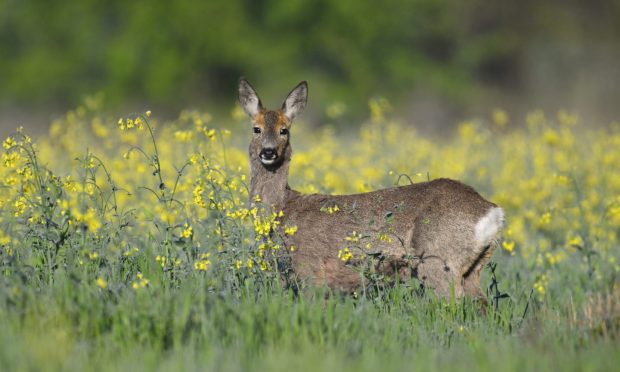A Caithness man whose dog attacked a deer while he was illegally hare coursing has become the first person in Scotland to be convicted and sentenced under new hunting legislation.
Nickolas Chenier’s golden lurcher was spotted chasing the animal into the Olrig cemetery car park before members of the public intervened.
Chenier killed the animal with a knife and loaded it into his van.
Investigators later matched DNA from hair and bone fragments found at the scene to a deer carcass found hanging in Chenier’s outbuilding.
Nickolas Chenier, 56, appeared at Wick Sheriff Court and admitted a charge of using his dog for hare coursing.
Chenier killed stricken deer with knife
Coursing is a wildlife crime where dogs such as greyhounds, salukis and other lurcher-type dogs are used to illegally chase, catch, injure and kill.
The offence falls under the Hunting With Dogs (Scotland) Act, which came into force in 2023.
The court heard how two witnesses saw a golden lurcher chasing the small roe deer from a field into a car park at Olrig cemetery on March 3 2024.
The deer was losing speed due to a broken front left leg and could eventually only run on its knees.
The witnesses then saw the dog take the deer to the ground and bite its legs and neck.
After they formed a huddle to protect the deer, Chenier appeared and confirmed the dog belonged to him.
Asked what he intended to do with the injured deer, he told them: “I’ll deal with it. I have a knife in the van.”
DNA evidence used to convict
The two witnesses then walked away separately but looked back to see Chenier had killed the deer and placed it in his van.
The incident was reported to the police and officers later searched the accused’s cottage where they found a golden lurcher in a kennel, which matched the description given by the witnesses.
They also discovered the carcass of a badly injured deer hanging from its hind legs above a tray of blood in an outbuilding.
DNA swabs from the deer carcass found at the accused’s address matched the DNA of the deer hair and bone fragments recovered from the cemetery car park.
Female dog DNA was also found on one of the swabs taken from the deer carcass.
Chenier was fined £790 and banned from owning or having a dog in his control for five years.
Landmark case for new legislation
Iain Batho, who leads on Wildlife and Environmental Crime for the Crown Office and Procurator Fiscal Service, said: “COPFS takes offences of hare coursing and any other hunting with dogs offences seriously and action will be taken against individuals where there is sufficient evidence of a crime and where it is in the public interest to do so.
“Hare coursing is a cruel and illegal act that can have a wide-ranging impact on both wildlife and rural communities.
“Whilst it was not Nickolas Chenier’s intention for his dog to attack and injure a deer that day, this incident shows that using dogs to hunt wildlife can have additional serious and unforeseen consequences.
“I welcome this first conviction under the Hunting with Dogs (Scotland) Act 2023 and, in particular, the message sent out about the court’s powers under that legislation to ban offenders from owning or having dogs for a period of time
“Our specialist wildlife prosecutors will continue to work to ensure those committing offences by hunting with dogs are brought to justice.”
‘Barbaric’ hunting practice has ‘no place in society’
Constable Erin Robinson of Thurso Police Station said: “Deer and hare coursing are barbaric and have no place in society. This often results in severe suffering for the animals and the dogs involved.
“I hope this sentence sends a clear message to those who commit these types of crimes that we will investigate and work with partners to seek prosecution.
Wildlife Crime Liaison Officer Daniel Sutherland added: “This was excellent partnership work with Scotland’s Rural College and Science and Advice for Scottish Agriculture (SASA) to bring this case to a conclusion.
“The deer was found hanging within the home address of Chenier and DNA work carried out on the carcass by SASA was crucial as it matched the hair and bone fragments found within the Olrig area.
“Female dog DNA was also found on one of the swabs taken from the deer carcass.
“I would encourage any member of the public who suspects hare or deer coursing is taking place to call Police Scotland 101 or 999 in an emergency.
“Also, if anyone has information regarding individuals whom they suspect of being involved in these types of crime, you can provide this anonymously through Crimestoppers on 0800 555 111.”
